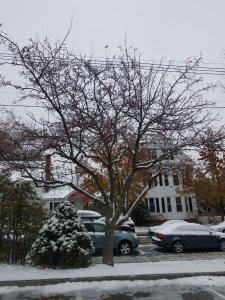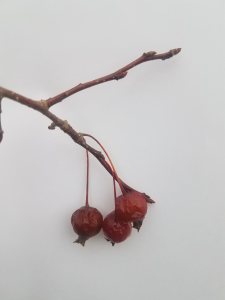Flowering Pear
Pyrus calleryana | Family: Rosaceae
Submission: Imogen Micklewhite ’22 and Emma Proietti ’21
 Leaves – Deciduous; simple; ovate to cordate shape; finely serrated margins with wavy appearance; 2-3” long, almost as wide as long; glabrous and leathery texture, glossy dark green color.
Leaves – Deciduous; simple; ovate to cordate shape; finely serrated margins with wavy appearance; 2-3” long, almost as wide as long; glabrous and leathery texture, glossy dark green color.
Twigs and Buds – Alternate branching; half-inch long terminal buds, very pubescent.
Fruit – A round yellow/tan or red pome about a half-inch in diameter with russet dots on skin of fruit.
Flower – Small white flowers formed in a 3” wide corymb; bloom late April to early May.
Bark – Light brown/gray; at maturity, bark has horizontal lenticels.
Natural History:
The flowering pear (Pyrus calleryana), also commonly called Bradford or Callery pear, is native to East and Southeast Asia and was brought to the United States in the early twentieth century. At that time, botanists were searching the globe for a pear species resistant to a bacterial blight plaguing the pear population native to the US; the flowering pear was one of a number of pear species brought from Asia to the US, where it was cultivated and bred in experimental orchards.
The flowering pear is known as a very adaptable tree and is capable of surviving in many different environments, including humid, arid, and air-polluted habitats. This ability, both to adapt to the environment and to be bred to grow in many shapes and sizes, has made the flowering pear a popular ornamental, planted in many urban areas and college campuses. A few cultivars were found to be most resistant to the bacterial blight, and so continue to serve as the rootstock for some fruit-producing pear trees.
 The flowering pear tree is self-incompatible, which means that it cannot self-pollinate to produce a fruit. Since the flowering pear arrived in the United States, many different cultivars have been developed and planted in huge numbers, mostly for ornamental purposes. As a result, some cultivars have become genetically distinct enough to cross-pollinate, which has caused a large increase in the flowering pear population, even granting it a spot on the invasive species list. Currently, in the United States, the flowering pear can be found in southeastern regions, but ranges from New Hampshire to Texas.
The flowering pear tree is self-incompatible, which means that it cannot self-pollinate to produce a fruit. Since the flowering pear arrived in the United States, many different cultivars have been developed and planted in huge numbers, mostly for ornamental purposes. As a result, some cultivars have become genetically distinct enough to cross-pollinate, which has caused a large increase in the flowering pear population, even granting it a spot on the invasive species list. Currently, in the United States, the flowering pear can be found in southeastern regions, but ranges from New Hampshire to Texas.
Beginning late April to early May, the flowering pear tree is an explosion of beautiful white flowers. These small flowers form in a cluster called a corymb, which is a candelabra-shaped array about three inches wide. This spring characteristic allows the tree to be easily discerned from afar. Up close, the tree can be identified by its ovate to cordate leaves that are two to three inches long with finely serrated, wavy margins and half-inch, fuzzy terminal buds. Additionally, while the fruit of this tree does not resemble a pear (despite its name), it does produce a round, half-inch pome which is yellow to tan or red in color with russet dots covering the skin.
The white flowers carpeting city sidewalks, college paths, and field edges are a familiar sight in spring. The frame of the branches complements the architecture of surrounding buildings and enhances the groomed appearance of any landscape. The trunks serve as the foundation for grafting many of the delicious pear species we eat today. The species spreads rapidly into new areas, quickly overtaking native species growing nearby. While gardeners are now encouraged to find and plant alternatives to the flowering pear, it remains as a landmark of many landscapes across the United States.
References:
Culley TM, Hardiman NA. 2007. The beginning of a new invasive plant: A history of the ornamental callery pear in the United States. BioScience. 57(11):956-964.
Pyrus calleryana. 2015. University of Connecticut: College of Agriculture, Health, and Natural Resources; [accessed 2019 November 22].